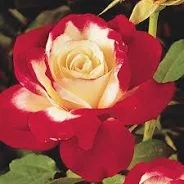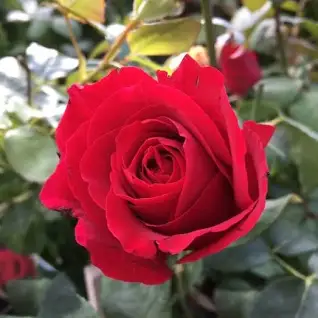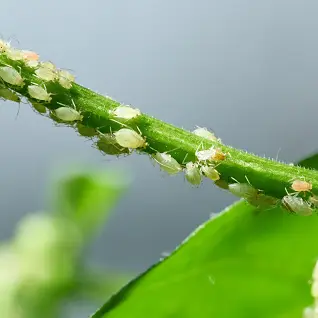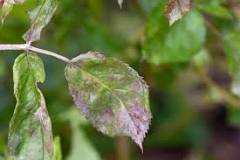Definition and Characteristics
Ah, the enchanting world of garden roses! These exquisite blooms are not only a feast for the eyes but also carry a rich tapestry of history and meaning.
Garden roses, also known as cultivated roses, are a diverse group of flowering plants that belong to the Rosa genus. What sets them apart from their wild counterparts is their intricate beauty, vibrant colors, and captivating fragrance.
From delicate petals to thorny stems, each part of a garden rose tells a story of elegance and grace. One of the defining characteristics of garden roses is their wide range of shapes and sizes.
Whether you prefer the classic form of Hybrid Tea Roses with their long stems and single blooms or the clustered blossoms of Floribunda Roses that create a stunning display, there is a garden rose variety to suit every taste. These roses come in an array of hues, from romantic reds to soft pinks and sunny yellows, adding a touch of warmth and charm to any garden or floral arrangement.
Historical Significance
The history of garden roses is as captivating as the flowers themselves. Dating back thousands of years, these blooms have been revered by ancient civilizations like the Greeks, Romans, and Persians for their beauty and symbolism.
In fact, it was during the Roman era that rose cultivation truly flourished, with vast gardens dedicated to growing these precious flowers for both ornamental and medicinal purposes. Throughout history, garden roses have been associated with various meanings and sentiments.
They have been symbols of love and passion in Greek mythology (think Aphrodite’s connection to roses), used in ancient Egypt for perfumes and decorations in tombs, and even adopted as emblems by royal families around the world. The enduring allure of garden roses lies not only in their physical beauty but also in the layers of significance woven into their petals over centuries.
The Beauty and Variety of Garden Roses
Hybrid Tea Roses: Elegance Personified

When it comes to garden roses, the Hybrid Tea variety reigns supreme in terms of elegance and beauty. These roses are prized for their classic shape and long, sturdy stems, making them perfect for cutting and displaying in bouquets. Hybrid Tea roses typically bloom on single long stems with one flower per stem, showcasing their exquisite form.
With a wide range of colors available, from delicate pastels to vibrant hues, Hybrid Tea roses are a favorite choice for many gardeners looking to add a touch of sophistication to their gardens. One popular example of a Hybrid Tea rose is the iconic ‘Mister Lincoln,’ known for its deep crimson-red petals and strong fragrance that fills the air with a rich, romantic aroma.
Another beloved variety is the ‘Peace Rose,’ featuring soft yellow petals with delicate pink edges—a symbol of harmony and tranquility in any garden setting. Whether you’re a seasoned rose enthusiast or a novice gardener looking to elevate your outdoor space, Hybrid Tea roses are sure to captivate you with their grace and charm.
Floribunda Roses: Abundance of Color
Floribunda roses are celebrated for their prolific clusters of blooms that create a stunning display of color in gardens. These roses are known for their compact growth habit and continuous blooming throughout the season, making them an excellent choice for adding vibrancy to borders or flower beds.
Floribundas come in a wide array of colors, ranging from soft pastels to bold jewel tones, ensuring there is a perfect hue for every gardener’s preference. One standout variety in the world of Floribunda roses is the ‘Queen Elizabeth’ rose, revered for its abundant clusters of pink blooms that exude regal elegance in any landscape.
With its vigorous growth and disease-resistant nature, the ‘Queen Elizabeth’ rose is a reliable choice for both experienced gardeners and beginners alike. Whether planted as focal points or used as mass plantings to create a kaleidoscope of color, Floribunda roses bring joy and beauty to any outdoor space they grace.
Grandiflora Roses: Majestic Presence
Grandiflora roses combine the best traits of Hybrid Teas and Floribundas, boasting large blooms on long stems that make them ideal for both cutting and garden display. These majestic roses offer an impressive presence in landscapes with their tall stature and striking flowers that command attention.
Grandifloras are known for producing clusters of blooms similar to Floribundas but on taller stems reminiscent of Hybrid Teas—a perfect blend of beauty and grandeur. With varieties like ‘Gold Medal’ showcasing golden-yellow blossoms tinged with hints of apricot, Grandiflora roses add warmth and sophistication to gardens with their rich color palette.
Their ability to bloom repeatedly throughout the season ensures a constant supply of stunning flowers that can be enjoyed both indoors and outdoors. Whether planted as standalone specimens or incorporated into mixed borders alongside other plants, Grandiflora roses make a bold statement wherever they grow.
Popular Varieties of Garden Roses
Peace Rose
The Peace Rose, also known as the ‘Madame A. Meilland,’ is a stunning hybrid tea rose that graces gardens with its elegant beauty and sweet fragrance. This rose variety was first introduced in 1945 and has since become a classic favorite among gardeners worldwide.
The Peace Rose features large, high-centered blooms with creamy-yellow petals that are delicately edged in pink, creating a striking contrast that is truly captivating. Known for its exceptional disease resistance and long-lasting blooms, the Peace Rose is a versatile choice for garden beds, borders, or even as a cut flower for arrangements.
Its vigorous growth habit and ability to bloom repeatedly throughout the growing season make it a popular choice for both novice and experienced rose enthusiasts. Planting the Peace Rose in well-draining soil and providing ample sunlight will ensure optimal growth and blooming performance.
Whether you’re looking to add a touch of elegance to your garden or create stunning floral arrangements, the Peace Rose is sure to delight with its timeless beauty and enchanting fragrance. With proper care and maintenance, this beloved variety will continue to grace your garden with its radiant blooms year after year.
Mister Lincoln Rose

The Mister Lincoln Rose is a classic hybrid tea rose named after the iconic President Abraham Lincoln due to its regal appearance and deep red color reminiscent of his political affiliation. This striking rose variety features large velvety petals in shades of deep red that exude elegance and sophistication in any garden setting. Known for its strong fragrance reminiscent of old-fashioned roses, the Mister Lincoln Rose adds a touch of nostalgia and romance wherever it blooms.
With its tall upright growth habit and long stems ideal for cutting, the Mister Lincoln Rose makes a perfect choice for adding dramatic flair to floral arrangements or creating focal points in flower beds. This enduring variety requires regular pruning to maintain its shape and promote healthy growth while also benefiting from consistent watering and fertilization throughout the growing season.
Whether planted as a standalone specimen or clustered together for added impact, the Mister Lincoln Rose commands attention with its bold coloration and exquisite form. Embodying timeless beauty and grace, this renowned rose cultivar continues to captivate hearts with its rich history and enduring allure.
Queen Elizabeth Rose
The Queen Elizabeth Rose is an enchanting grandiflora rose variety renowned for its soft pink petals that exude elegance and grace reminiscent of royalty – fittingly named after Her Majesty Queen Elizabeth II herself. This exquisite rose cultivar showcases large clusters of double blooms that emit a delicate fragrance, creating a sense of charm and sophistication in any garden landscape.
With its vigorous growth habit and abundant flowering capabilities, the Queen Elizabeth Rose is an ideal choice for adding beauty to outdoor spaces. Thriving in full sun exposure with well-draining soil enriched with organic matter, the Queen Elizabeth Rose rewards gardeners with continuous flushes of gorgeous blooms from spring through fall.
Its disease-resistant nature makes it relatively easy to care for compared to other rose varieties while still offering outstanding visual appeal that complements various gardening styles. Whether planted as hedges along pathways or featured prominently as standalone specimens in flower beds, the Queen Elizabeth Rose shines brightly with its captivating pink blossoms that evoke feelings of serenity…
Planting Location and Soil Requirements
When it comes to planting your garden roses, selecting the right location is crucial for their overall health and growth. Choose a spot that receives at least six hours of sunlight daily, as roses thrive in full sun.
Additionally, make sure the area has good air circulation to prevent diseases. As for soil requirements, garden roses prefer well-draining soil that is rich in organic matter.
You can improve the soil quality by adding compost or aged manure before planting. Before planting your roses, it’s essential to prepare the soil properly.
Dig a hole that is slightly larger than the root ball of the rose plant. Gently loosen the roots before placing the plant in the hole, making sure it sits at the same depth as it was in its container.
Backfill with soil and press down firmly to remove any air pockets. Water thoroughly after planting to help settle the soil around the roots.
Watering and Fertilizing Guidelines
Proper watering is key to keeping your garden roses healthy and vibrant. Water deeply but infrequently to encourage deep root growth and avoid shallow watering that can lead to weak plants. During hot weather or drought conditions, increase watering frequency accordingly.
It’s best to water early in the morning or late in the evening to minimize evaporation loss. In terms of fertilizing, garden roses benefit from regular feeding throughout the growing season.
Use a balanced fertilizer specifically formulated for roses and follow package instructions for application rates. Start fertilizing in early spring when new growth appears and continue through summer, tapering off in late summer to allow plants to harden off before winter.
Pruning Techniques
Pruning is an essential aspect of rose care that helps promote healthy growth, improve flowering, and maintain plant shape. The best time to prune garden roses is typically in late winter or early spring before new growth begins.
Remove any dead, diseased, or damaged wood first, cutting back to healthy tissue using sharp pruning shears. To encourage bushy growth and abundant blooms, prune your rose bushes lightly but regularly throughout the growing season by deadheading spent flowers and removing weak or crossing branches.
Pay attention to each type of rose variety as pruning techniques may vary slightly between hybrid teas, floribundas, grandifloras, etc. Remember always sterilize your pruning tools with rubbing alcohol between cuts to prevent disease spread among plants!
Aphids: Tiny Troublemakers in the Garden

Ah, aphids – those pesky little critters that can wreak havoc on your beautiful garden roses. These tiny insects may be small, but they can cause big problems if left unchecked.
Aphids feed on the sap of plants, including rose bushes, by piercing the plant tissue with their needle-like mouthparts. This feeding can lead to distorted growth, yellowing leaves, and even the spread of diseases.
One of the telltale signs of an aphid infestation on your garden roses is the presence of sticky honeydew residue on the leaves and stems. This sticky substance is excreted by aphids as they feed and can attract other pests like ants.
To combat aphids naturally, you can introduce beneficial insects like ladybugs or lacewings to your garden, as they are natural predators of aphids. Alternatively, a strong blast of water from a hose can help dislodge aphids from your rose bushes.
Black Spot: The Bane of Rose Gardeners Everywhere
Black spot is a common fungal disease that affects many varieties of roses, including garden roses. This unsightly disease manifests as circular black spots with fringed edges on the leaves of infected plants. If left untreated, black spot can weaken your rose bushes and lead to defoliation over time.
Preventing black spot starts with good cultural practices, such as planting roses in well-drained soil and providing adequate air circulation around plants. Avoid overhead watering to reduce moisture on foliage, which creates favorable conditions for black spot development.
If black spot does appear on your rose bushes, remove and destroy affected leaves promptly to prevent further spread. Organic fungicides containing neem oil or sulfur may also help control black spot infestations.
Powdery Mildew: A Fuzzy Fungal Nuisance

Powdery mildew is another common fungal disease that garden rose enthusiasts often have to contend with. This fuzzy white or grayish powder-like substance typically appears on the upper surfaces of leaves and stems.
Powdery mildew thrives in warm, humid conditions with poor air circulation – sound familiar? To combat powdery mildew on your garden roses, try increasing air circulation around plants by pruning overcrowded branches and maintaining proper spacing between rose bushes.
Watering at the base of plants early in the day so foliage has time to dry out can also help prevent powdery mildew infections. For natural control measures, you can use homemade remedies like a mixture of baking soda and water sprayed onto affected areas or commercial fungicidal sprays labeled for powdery mildew control.
Fun Facts about Garden Roses
Roses are Edible!
Did you know that roses are not just beautiful to look at, but they are also edible? That’s right! Rose petals can be used in a variety of culinary creations, adding a delicate floral flavor and a pop of color.
You can sprinkle rose petals on salads for a touch of elegance, infuse them into desserts like cakes and jams for a unique twist, or even steep them in hot water to make fragrant rose tea. So next time you’re in the garden admiring your roses, remember that they can also tickle your taste buds.
The World’s Oldest Living Rose
Imagine a rose that has been blooming for over 1,000 years – it almost sounds like something out of a fairy tale! But this remarkable feat is true for the world’s oldest living rose, which thrives on the wall of the Hildesheim Cathedral in Germany.
This ancient beauty has weathered centuries of history, wars, and changing landscapes, standing as a symbol of resilience and endurance. It serves as a living testament to the timeless allure and enduring nature of roses.
Roses as Symbols Throughout History
Roses have held symbolic significance across various cultures and time periods. In the language of flowers, roses have long been associated with love and passion – red roses represent romantic love while yellow roses symbolize friendship. However, beyond matters of the heart, roses have also been linked to beauty, war, and politics throughout history.
From being used as emblems by royal houses to adorning shields in battlefields, roses have left their mark on art, literature, and societal customs worldwide. Their versatility as symbols highlights the deep-rooted connection between humanity and these exquisite blooms.
Resources for Further Learning
Recommended Books on Gardening with Roses
If you’re looking to dive deeper into the world of garden roses, there are some fantastic books that can guide you on your botanical journey. “The Rose Expert” by D.G. Hessayon is a classic choice, offering practical advice and tips for rose enthusiasts of all levels.
For those interested in the history and cultural significance of roses, “The Meaning of Flowers: Myth, Language & Lore” by Gretchen Scoble and Ann Field is a delightful read. And if you’re seeking inspiration for designing your rose garden, check out “Roses Without Chemicals” by Peter Kukielski for eco-friendly gardening solutions.
Online Communities for Rose Enthusiasts
Connecting with fellow rose lovers can be a rewarding experience that enhances your passion for these beautiful blooms. Online communities provide a platform to share knowledge, seek advice, and celebrate the beauty of garden roses together.
The GardenWeb Rose Forum is a popular online hub where enthusiasts from around the world come together to discuss everything from planting tips to pest control strategies. The American Rose Society also offers an online community where members can engage in forums, access educational resources, and participate in local rose events.
Summary
In the vibrant world of garden roses, there is endless beauty to explore and knowledge to gain. Whether you are just starting your journey as a rose enthusiast or already have a thriving rose garden, the allure of these iconic flowers is undeniable.
Remember that every petal tells a story, every thorn teaches resilience, and every bloom symbolizes growth and renewal. Embrace the timeless elegance of garden roses in all their varieties and colors, and let their enchanting presence bring joy and inspiration to your life’s botanical tapestry.
